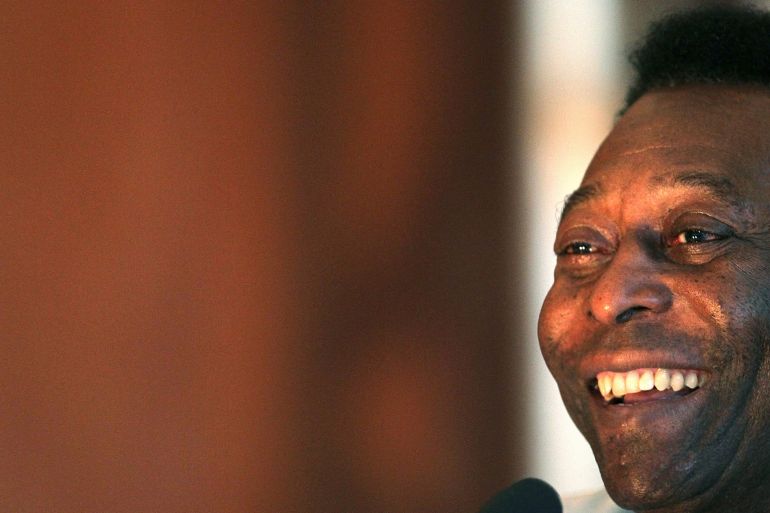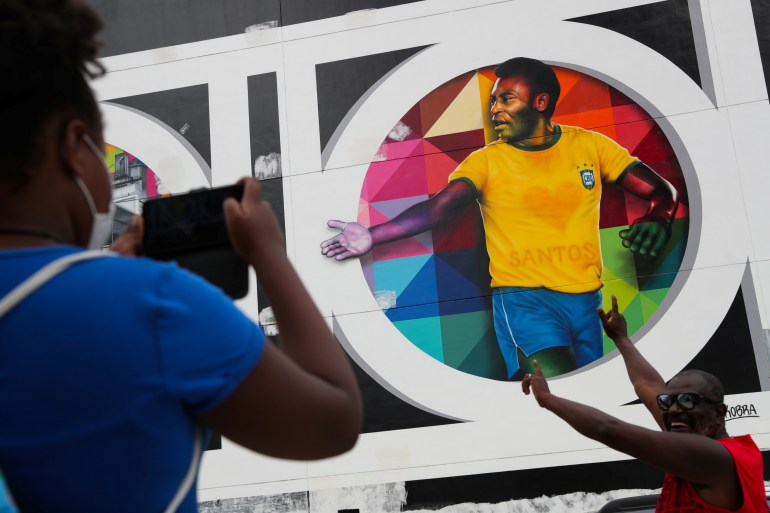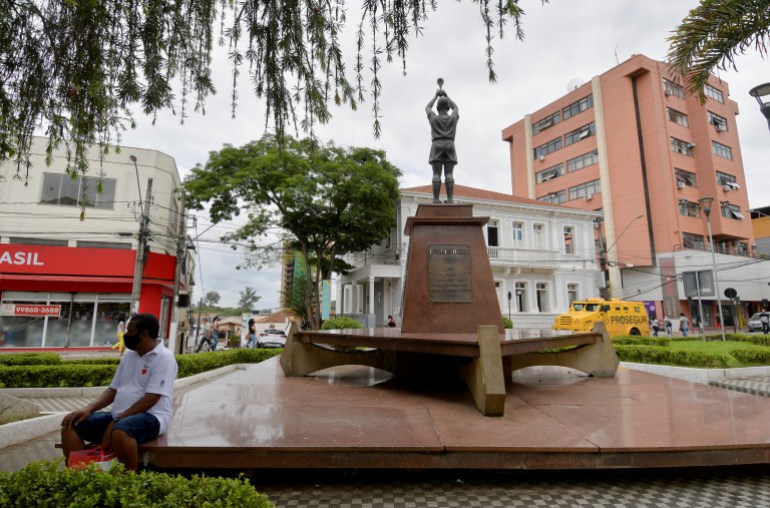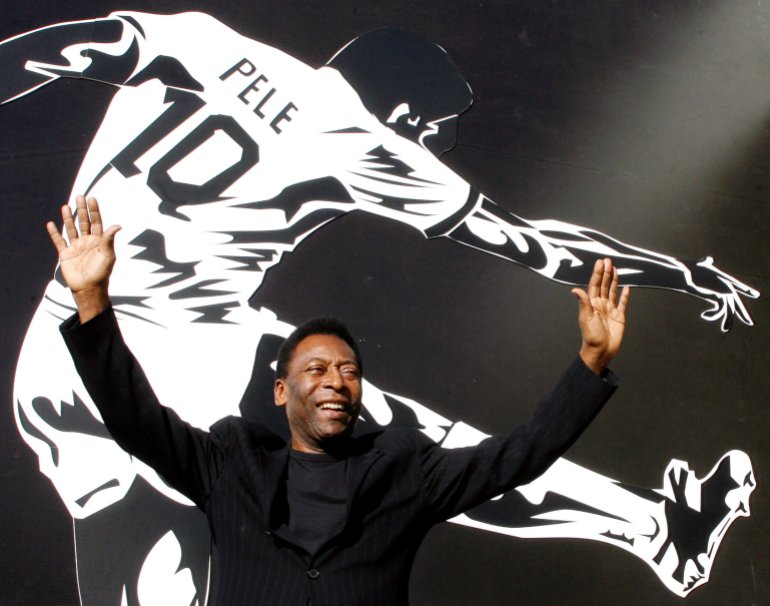Brazilian football icon Pele leaves an unparalleled legacy
During his two-decade career, Brazilian footballer became the world’s first truly global sporting superstar.

Sao Paulo, Brazil – On July 16, 1950, Brazil faced Uruguay to decide who would lift the World Cup. Hosting the tournament on home soil for the first time, the Brazilian team simply needed to avoid defeat against their neighbours to become world champions.
Meanwhile, in the small Brazilian city of Bauru, an excitable nine-year-old named Edson Arantes do Nascimento played outside while his father was glued to the radio, willing Brazil on to their first World Cup title. When the match was over and Uruguay had pulled off a shock 2-1 win, Edson overheard his father weeping.
Keep reading
list of 4 itemsWhat ‘King’ Pele means to football fans
Brazil dedicates World Cup win to ailing football legend Pele
Pele: I’m strong with a lot of hope
“Don’t cry, Dad,” he said, “I’ll win the World Cup for you.”
Young Edson would grow up to become Pele, arguably the greatest footballer to ever play the sport, who died Thursday aged 82.
During his 21-year career, Pele won 37 titles and scored 1,279 goals – an all-time record. He is the only player to have won the World Cup three times, doing so on the way to becoming a national and global icon who transcended the sport.
Pele had been in a Sao Paolo hospital since November being treated for worsening colon cancer and kidney and heart problems. His family had gathered at the hospital last week and confirmed his death Thursday.

Early days
Born in the southeastern Brazilian city of Tres Coracoes to parents Dondinho and Celeste Arantes, Pele moved around a lot as a boy due to his father’s career as a budding professional footballer. When Dondinho suffered a career-ending knee injury on the cusp of his big break at a top-level Brazilian club, the family put down roots in Bauru, a city some 300 km from Sao Paulo.
Pele idolised Dondinho, and had every intention of following in his father’s footsteps and becoming a footballer. But his mother was not keen on the idea, having witnessed first-hand the fragility and uncertainty of a life as an aspiring athlete.
Pele’s precocious talent, however, meant that a career in football was unavoidable – and at the age of 15, he was snapped up by Santos and packed his bags to live on the Sao Paulo coast.
“I was the first Santos player to meet him when he arrived,” recalls Jose Macia, better known as Pepe, who played alongside Pele for 13 years. “I was getting a haircut and he was there, sipping a coffee in a brand new blue suit. They told me it was the first time he’d ever worn trousers.
“I went to shake his hand and he almost broke my fingers,” Pepe tells Al Jazeera. “I thought to myself: ‘This kid is determined.'”

Almost immediately, Pele broke into the Santos first team and began grabbing headlines with his goal-scoring prowess. His newfound fame earned him his first call-up for the Brazilian national team at just 16.
“He was very fortunate to join Santos when he did,” South American football expert and journalist Tim Vickery tells Al Jazeera. “He came into a fantastic club full of wonderful players; it was a great way to bed in. Within a year of the start of his career, he was already acknowledged by those around him as an absolute phenomenon.”
Pele’s first taste of the World Cup came the following year, when he was selected to be part of Brazil’s squad for the 1958 tournament in Sweden. He began the competition as a substitute, partly due to a psych evaluation carried out by a national team doctor that concluded he was “obviously infantile” and not suited to professional sport.
After working his way into the starting 11, however, the 17-year-old Pele steered Brazil to victory, scoring two goals in the final against Sweden.
Pele would win another World Cup medal four years later, though the 1962 tournament left a bitter taste in his mouth. In only his second game of the competition, he suffered a thigh injury and watched from the sidelines as his teammates marched to victory.

‘Extra-terrestrial’ talent
Indeed, the World Cup never saw Pele at his phenomenal best. During the early 1960s, his Santos team was virtually unbeatable, and Pele was at his physical peak. Not only was he extremely intelligent and skilled, he was also faster and stronger than his opponents.
“Everyone said that it must have been easy to play alongside Pele, but that’s nonsense,” Pepe says. “It was really difficult. You had to guess what he was thinking, because he did incredible things that no normal player would be able to do.
“He used to tell me he was just a normal guy, but he wasn’t. He was a Martian, an extra-terrestrial.”
To ward off interest from major European clubs, Santos broke the bank to pay Pele an exorbitant salary, far beyond its financial capacity. To pay for his contract, the club embarked on a seemingly endless series of foreign excursions, playing friendly matches in cities around the world.
Thousands of locals would flock to catch a glimpse of Pele in action, cementing his status as the world’s first truly global sporting superstar.

More than 500 of Pele’s 1,279 career goals came in these friendly matches, which has been a source of derision from football fans and commentators alike. “It’s difficult for younger generations and those outside South America to relate to Brazilian football as it was played in the 1960s,” explains Thales Machado, head sports editor of the Brazilian newspaper O Globo. “These were huge matches; the press gave them major coverage at the time.”
Pele’s crowning football achievement came at the 1970 World Cup in Mexico, the first tournament to be broadcast in colour to televisions in parts of Europe and the US. At 29, Pele led the attack of a Brazilian team chock full of superstars, often regarded as the greatest World Cup-winning side of all time.
While seemingly exempt from criticism on the pitch, Pele’s off-field persona was the subject of much frustration for many Brazilians. During the 1970 World Cup, Brazil was under violent military rule, and Pele was often criticised for being overly friendly towards the authoritarian army generals in charge of the government, appearing alongside then-President Emilio Garrastazu Medici at public events and showing his willingness to act as a sporting ambassador for the military regime.
Yet, in Brazil, his sporting success trumped any misgivings about his personality off the pitch, and he remained a national hero until his death. “It’s all about winning in Brazil,” Vickery says. “And Pele allowed Brazil to win.”
Brazilian football legend Pelé has died at age 82.
Here’s what other football legends had to say about the man who scored over 1,200 career goals ⤵️
🔗: https://t.co/DgZ7V4bRmd pic.twitter.com/KUTISLkZXu
— Al Jazeera English (@AJEnglish) December 29, 2022